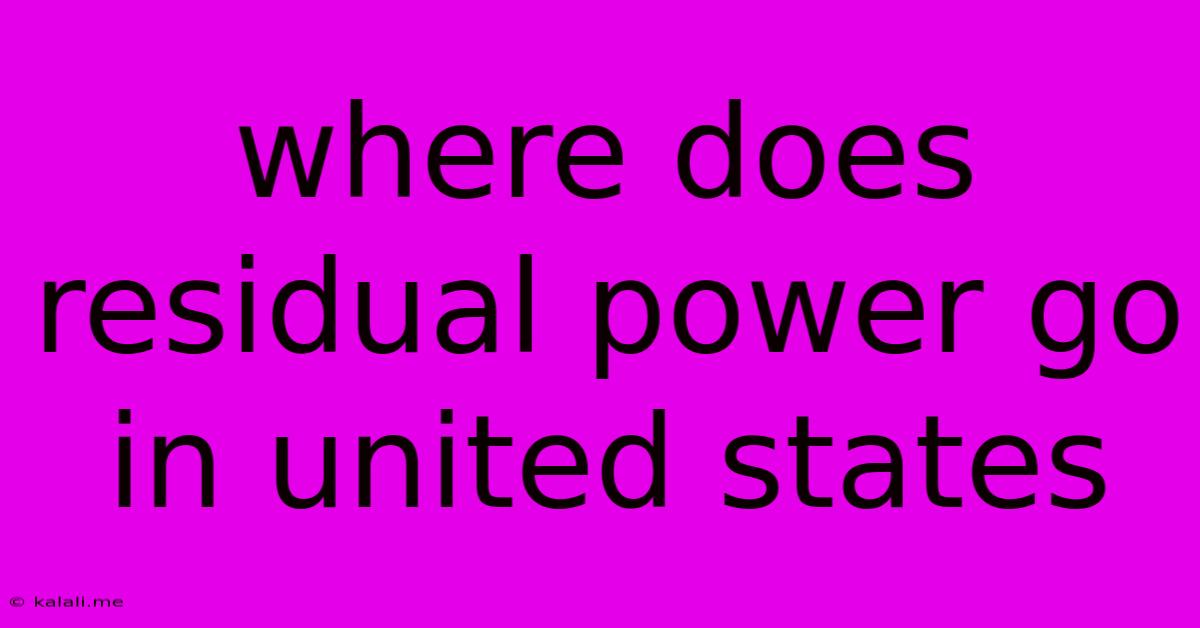Where Does Residual Power Go In United States
Kalali
Jun 03, 2025 · 3 min read

Table of Contents
Where Does Residual Power Go in the United States? Understanding the Complexities of Electricity Generation and Distribution
The question of where residual power goes in the United States is not a simple one. It involves understanding the intricacies of electricity generation, transmission, distribution, and consumption, as well as the various regulatory bodies involved. There's no single "dumping ground" for excess electricity; instead, several mechanisms are in place to manage and utilize surplus power. This article will explore these different avenues.
Understanding Residual Power
Before delving into the destination of surplus power, let's define what we mean by "residual power." This refers to electricity generated beyond the immediate demand at a given time. This excess can occur due to various factors, including:
- Overgeneration: Power plants may produce more electricity than currently needed due to unexpected shifts in demand, weather conditions affecting renewable energy production (e.g., excessive solar power on a sunny day), or simply operational inefficiencies.
- Unexpectedly Low Demand: Periods of low energy consumption, such as during off-peak hours or holidays, can result in a surplus of electricity.
Methods for Managing Residual Power
Several methods are employed to handle this surplus energy:
1. Grid Storage: The Growing Solution
One increasingly important method is grid-scale energy storage. This involves storing excess electricity in various forms, such as:
- Pumped hydro storage: Water is pumped uphill to a reservoir when excess power is available and released to generate electricity when demand increases.
- Battery storage: Large-scale battery systems store excess energy and release it as needed, improving grid stability and reliability.
- Compressed air energy storage (CAES): Excess electricity is used to compress air, which is then used to generate electricity when demand is high.
These storage solutions are crucial for balancing supply and demand, mitigating the intermittency of renewable energy sources, and providing grid stability.
2. Demand-Side Management (DSM) Programs
Utility companies often implement demand-side management (DSM) programs to encourage consumers to shift their energy consumption to off-peak hours. This can reduce the need to generate excess power during peak demand periods. These programs may include:
- Time-of-use pricing: Charging customers different rates depending on the time of day.
- Incentives for energy efficiency: Offering rebates or other incentives for energy-efficient appliances and practices.
3. Curtailment of Renewable Energy Sources
In some cases, particularly with solar and wind power, excess generation can lead to curtailment. This involves intentionally reducing the output of renewable energy facilities to prevent overloading the grid. While this seems wasteful, it's sometimes a necessary measure to maintain grid stability and prevent damage.
4. Export to Other Grids
Depending on regional grid interconnections, surplus electricity can be exported to neighboring states or regions. This helps balance regional energy supply and demand. The Western Electricity Coordinating Council (WECC) and the Eastern Interconnection are key examples of large interconnected grids facilitating this power exchange.
5. Loss in Transmission and Distribution
Unfortunately, some residual power is inevitably lost during transmission and distribution. This loss is inherent in the process of moving electricity across long distances and through various infrastructure components.
The Future of Residual Power Management
The efficient management of residual power is crucial for the transition to a cleaner and more sustainable energy future. As renewable energy sources become more prevalent, advanced grid technologies, including smart grids and improved energy storage solutions, will become increasingly critical in managing the fluctuating nature of renewable energy generation and ensuring reliable power delivery. Continued investment in grid modernization and smart grid technologies are essential for the effective utilization of excess power and ensuring grid stability in the face of a rapidly evolving energy landscape.
Latest Posts
Latest Posts
-
Three Way Switch With Dimmer Wiring Diagram
Jun 05, 2025
-
Integral Of Ln X 2 1
Jun 05, 2025
-
The Survival Game Future Diary
Jun 05, 2025
-
How Can You Tell If Acorn Squash Is Ripe
Jun 05, 2025
-
2 Stroke And 4 Stroke Difference
Jun 05, 2025
Related Post
Thank you for visiting our website which covers about Where Does Residual Power Go In United States . We hope the information provided has been useful to you. Feel free to contact us if you have any questions or need further assistance. See you next time and don't miss to bookmark.